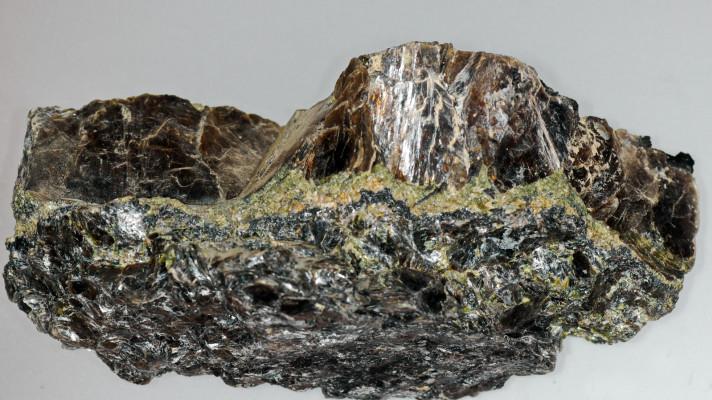Understanding of potential flood disasters is highly important for better socio-economic management as disaster risk reduction and emergency management.
AN OVERVIEW OF TORRENTIAL RAINS TRIGGERED FLASH FLOOD IN NORTHERN KYUSHU, JAPAN-JULY 2012
Understanding of potential flood disasters is highly important for better socio-economic management as disaster risk reduction and emergency management. Japan is the most prone country in the world by suffering natural disaster such as earthquake, typhoon, volcanic activity and tsunami. Average precipitation in Japan varies among 1106.5 mm in north part of Japan to 2265.7 mm in south part of country (Japan Meteorological Agency, 2012). However, irregular precipitation often brings torrential rains and trigger floods. Floods are one of the most common natural disasters occur in the world. In some places, floods occur nearly regularly, in others very rarely, however then become more unexpectedly therefore dangerously.
Precipitation in Japan
Japan location and climate condition bring high precipitation mainly in three periods: the rainy season, typhoon season and snowfall period (Ikeya, 1989). The rainy seasons occurs from June to mid-July and extend from Kyushu to Tohoku region. The low pressure areas move from west to east along this front. In the early period, precipitation is not intensive however heavy rain often occurs at the end of season. Typhoons are tropical cyclones originating in the seas south of Japan and have a velocity of more than 17 m/sec. Typhoons hit Japan mostly in August and September and reaching average 20 typhoons per year (Japan Meteorological Agency, 2012). Typhoons bring heavy rainfall when they landfall and pass through Japanese islands. Snowfall season occurs from November to March mainly in north part of Japan when the dry, cold air seasonal winds from Siberian air mass in the northwest absorb moisture from the warmer water of the Japan Sea. Then the moisture is changed into snow. Thus, intensive rainfalls have been reported during the Typhoons and towards the end of rainy season which has resulted local floods.
TYPE OF FLOODS
Floods are usually classified in three main types: river flood, flash flood and storm surge. Besides the main types of floods, floods could be occurred with ice floods, backwater, rising groundwater, rising sea levels, glacial lake outburst, and tsunamis.
River Floods
River floods are the result of intensive rainfall lasting a period of days over a large area of watershed. River floods do not take place suddenly however develop gradually. As a main indication, they last from a few days to several weeks. The affected area may be very extensive if the river basin is flat and wide and the amount of river water flowing is large. On the other hand, in narrow valleys, the flooded area is limited to thin area along the river, however the water level can be high also flow at high speeds therefore get strong power to harm riverside (Barredo, 2007).
Flash Floods
Flash floods are sudden local flood of great volume and short duration occur which occur after heavy or torrential rain, usually in relation with a thunderstorm. A flash flood can be caused also due to dam or levee failure, or the sudden release of water impounded by an ice log jam. Flash floods happen after the rainfall, predominantly when is soil fully saturated or the ground is frozen. The onset is in fact very rapid considering minutes or a few hours before reaching discharge peak besides and so the ending is mostly fast as beginning however the rain intensity is reaching 100 mm per hour and even more. Flash floods are not always connected with water bodies therefore it more depends on local conditions. Heavy rains, mostly related to convection clouds, cover small area and could be boost by hails and strong wind.
Storm surge
Storm surge, in short, can only occur along the coast of seas and big lakes. Continuous strong wind from one direction causes pushing up water on the coastline and could reach several metres. Therefore astronomical high tide and low atmosphere pressure of tropical cyclone are connected with intensifying water level. Significant role also play sea bottom profile, which is particularly enlarging surge in shallow gulf seas and river estuaries therefore in areas where the water cannot escape sideways or downwards. The storm surges are causing main loss of lives during tropical storms accounting almost 90% victims.
2012 JULY FLOODS IN KYUSHU, JAPAN
Every year between middle of June till middle of July rainy season comes to Japanese islands predominantly excluding Hokkaido. Precipitation in Kyushu Island takes place from middle of June till middle of July mostly bringing most of heavy rainfall during the last period. Since July 11th till July 14th 2012, enormous amount of heavy rain occurred in Northern part of Kyushu Island, Japan. The strongest rain precipitation took place in Otohime, Aso city in Kumamoto prefecture accounting 507.5 mm of rain precipitation in 24 hours besides 108.0 mm in 1 hour (Japan Meteorological Agency, 2012). This heavy downpour cause several local floods, landslides and debris flows which cost 32 losses of lives. The most impacted place become Aso city, where landslide buried 19 people. Moreover, almost 400 000 people were ordered or advised to leave their homes therefore this number is even higher than in Tohoku disaster. The other impacted places become significant mainly Hita city and Takeda in Oita prefecture. The Chikugo River which is the longest on Kyushu has been restored to sustain floods by widening banks and levee construction. Therefore the biggest damage was in account of small rivers and creeks.
|
 Precipitation record 11.7-14.7 2012
|
|||
|
1Hour Precipitation
|
|||
|
Prefecture
|
City District
|
Location
|
Precipitation (mm)
|
|
Kumamoto
|
Aso
|
Otohime
|
108.0
|
|
Kanagawa
|
Yamakita
|
Tanzawako
|
104.5
|
|
Kagoshima
|
Minamitane Tanegashima Island
|
Kaminaka
|
103.0
|
|
|
|||
|
24Hours Precipitation
|
|||
|
Kumamoto
|
Aso
|
Otohime
|
507.5
|
|
Fukuoka
|
Yame
|
Kurogi
|
486.0
|
|
Oita
|
Hita
|
Tsubakigahana
|
396.0
|
|
|
|||
|
Total Precipitation
|
|||
|
Kumamoto
|
Aso
|
Otohime
|
816.5
|
|
Oita
|
Hita
|
Tsubakigahana
|
656.5
|
|
Fukuoka
|
Yame
|
Kurogi
|
649.0
|
(Japan Meteorological Agency, 2012)
Cause of landslide and floods
There are several factors which boost flash flood and also create landslide related to basin and discharge, rainfall and consequences (Gaume, et al., 2009):
. Basin area
. Time of concentration
. Minimum elevation
. Average elevation
. Average basin slope
. Land use
. Soils
. Average soil sickness
. Geology
Discharge data
. ![]() Peak discharge
Peak discharge
. Estimation method
. Regulated stream (y/n)
. Peak discharge Maxi
. ![]() Peak discharge mini
Peak discharge mini
. 10-year discharge (m3/s)
. 100-year discharge (m3/s)
. Sediment processes (y/n)
. Flood duration (h)
Rainfall data
. Total point rainfall (mm)
. Rainfall duration (h)
. Average rainfall on the basin (mm)
Damages and casualties
. Total damages (currency)
. Displaced persons
. Population affected
. No of casualties and injured people
. Circumstances
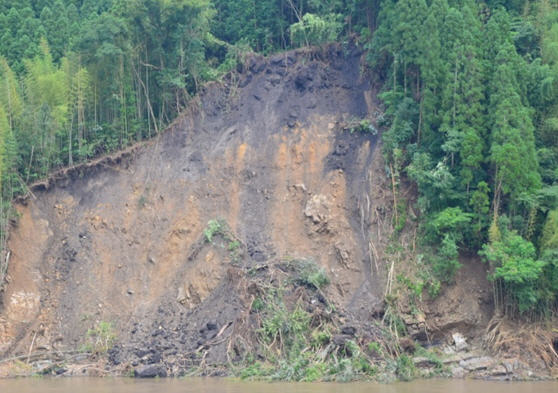
|
Forestry and flood control in Japan
Japanese archipelago is covered more than 65% by forests (250 000 km2 in area) therefore it is one of the highest in world. During and after the Second World War Japan was lacked of resources so that huge amount of domestic timber was used for post-war recovery. However, this fast deforestation lead to many environmental problems such as floods and landslides which become significant mainly in 1945 when Typhoon Makurazaki made landfall in Japan and stroked Hiroshima city and caused 2 473 casualties, then Typhoon Kathleen hit Kanto area with 1 100 loss of lives. Moreover, the Isewan Typhoon of 1959 was one of the most destructive and left 5 098 people dead (Oda, 2005). Since this disasters occur regularly government support reforestation of Japan to moderate run off from the mountains which cover 73% of the land. Forest cover provides soil erosion control by tree roots and vegetation; retain rain water runoff by soil absorption beside clear the water and storage water in tree and also preserve biodiversity. As the primary tree were chosen Chamaecyparis obtuse (Japanese cypress)and Cryptomeria japonica (Sugi)due to high demand for timber and relatively high growth. Nowadays, this plantations account 41% of Japanese forest (103 600 km2) so that it also one of the highest comparing to other nations (Iwamoto, 2003). Reforestation was subsides by government to support this process however, due to high cost of Japanese labour and low-cost imported tropical timber from Southeast Asia, Japanese forest has not been cultivated and harvested according to forest rules such as thinning and pruning. Thus most of this plantation has become abandoned and forest cover does not provide all. Indeed, this forest density reach to Ry 1 though the most recommend is 0.5-0.7 as in natural forest (Razafindrabe, et al., 2010). Therefore these high dense covers limits sun shine on the ground and inhibit growth of new trees and mainly vegetation. Since the ground becomes mainly uncovered soil it decrease retaining capacity and accelerate water runoff at steep slope (Roy C. Sidle, et al., 2007). Horton overland flow is common in area lacking of vegetation such as arid area, compacted soil and paved urban areas on the other hand it is rare in forest especially tropical and subtropical. However this phenomenon has been noticed and proved by many scientists in Japanese plantation forest as one of a factor to exaggerate flash floods (Onda Y., 2010 and Genet M, et al., 2006). Moreover, many trees which are not used in wood industry and are left in forest and transport during heavy rain by flow as debris flow so that aggravate situation.
Disaster waste after flash floods in Kyushu 2012
During the Kyushu floods in July 2012 most of cities were damaged not only by river flow, landslides and debris flow but also by floating logs which due to its weight and kinetic energy smashed up dwellings and also accumulating and blocking the bridges worsen the circumstances. The recovery has started immediately when the water drop off by cleaning damaged dwellings. Municipality government provided free transport of flood waste therefore it was separated into combustible, metals, tires, e-waste and tatami-Japanese mattress at temporary storage sites. Large wood logs were removed from the bridges and riverbed and become source of biomass as waste to energy. However, these logs were not damaged by any chemical nor radiation pollution besides considering waste as a resource and waste hierarchy it would be more efficient to reuse it as construction material. Logs could be utilized for making boards and lumber by portable sawmill as citizen desired and needed size so that wood debris could really contribute in affected areas. The disadvantage is high moisture content in the boards which can reach to 60% and the wood products could not be immediately used however comparing to damaged wood boards and lumber containing even higher moisture content after flooding and also mud so that this parts are more vulnerable to fungi and insects. The damaged wood fraction should be utilized as fuel source and convert into energy at energy plant.
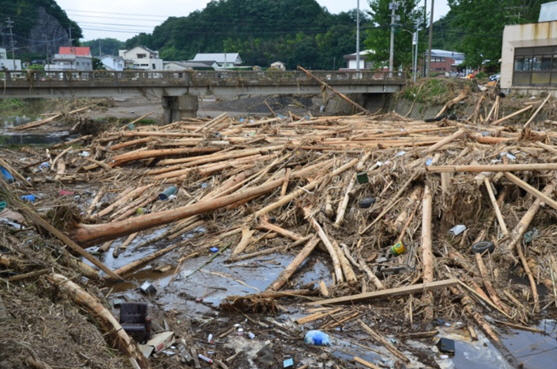
|
|
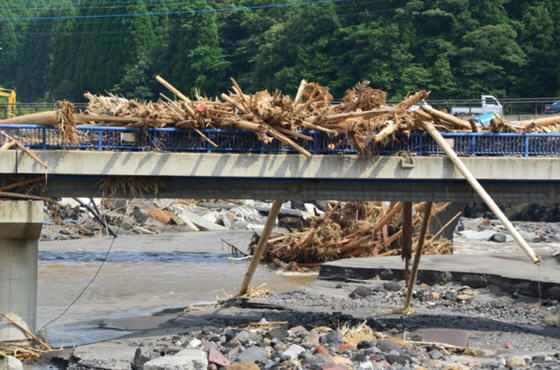
Disaster risk reduction against flash floods damage by wood debris
Disaster risk reduction is mainly characterized by prevention control which is mostly the most effective on the other hand also the most complicated. Certainly, the most important task is saving lives therefore warning and evacuation systems must be implemented. In case of Japan, the most prepared country this warning system has been developed and used for many years however, it is still hard to precisely predict heavy rainfall consequences such as landslides and debris flow. In this case, more investigation should be carry out in steep slopes in danger of those phenomena.
Regarding to wood debris flow control and prevention (Ikeya,1989) it should be consider several aspects:
1) Is the stream a debris flow dangerous torrent or not?
2) Can a countermeasure be executed in the area of debris flow occurrence?
3) Is there a buffer zone?
4) Can a civil engineering method be employed?
5) Can the countermeasures be explained by software methods?
Debris flow preventive measure based on civil engineering methods are following this type of measure:
1) Preventing the occurrence of debris flow.
2) Stopping or causing deposition of the moving debris flow.
3) Transforming the debris flow to sediment flow or traction flow.
4) Enabling the debris flow to flow down to lower reaches of the river without causing damage.
DISCUSSION AND CONCLUSION
Several things could be learning from Kyushu floods and used in future. Regarding to rain prediction and emergency warning it should be consider mainly in hill side region and advice evacuation during long time rain period when the soil is fully absorbed by moisture and cannot retain precipitation therefore all water flows into basin.
First of all, primary approach should be given to prevention measures therefore recover Japanese forestry. The process must include reforestation and change from plantation forest into natural forest or close to nature forest management and utilizing timber. Restored forest would be more sustainable without human impact and mainly more retain precipitation and limit Horton overland flow. In addition, transport wood from forest would eliminate wood debris flow amount during torrential rain therefore reduce damage cost from drifting wood.
The other countermeasure should focus on building buffer zone around river where dangerous torrent could occur. Buffer zone would contribute to stop drifting wood by tree and vegetation. Therefore even log-jams trap reduce rates of transport along the river bed by decreasing energy gradients and increasing channel roughness (Montgomery, 1997).
Transforming the debris flow to sediment and traction flow and enabling the debris flow to flow down to lower reaches without causing damage should be applied as the last alternative especially at populated areas. This option is feasible at wide rivers with enough buffer zone. Therefore attention must be paid to protect bridges and other construction on river banks.
This paper has given an account of and the reasons for the cause and prevention of Kyushu floods in July 2012. In this investigation, the aim was to countermeasures to limit damage caused by floods. Plantation forestry is the main reason which failed to retain more precipitation. Therefore, the result of this study indicates that restoring plantation monoculture cover into close to nature forest management is one of the most feasible options to prevent high loss of lives during torrential rain.
REFERENCES
Bam H. N. Razafindrabe , Bin He, Shoji Inoue, Tsugio Ezaki, Rajib Shaw (2010): The role of forest stand density in controlling soil erosion: implications to sediment-related disaster in Japan, Environmental Monitor Assess 160, 337-354.
David R. Montgomery (1997): What´s best on the banks?, Nature, Volume 388
Eric Gaume, Valerie Bain, Pietro Bernardara, Olivier Newinger, Mihai Barbuc, Allen Bateman, Lotta Blaskovicova et al(2009): A compilation of data on European flash floods, Journal of Hydrology 367, 70-78.
Hiroshi Ikeya (1989): Debris flow and its countermeasure in Japan, Bulletin of the International Association of Engineering Geology, Paris.
Japan Meteorological Agency (2012): Heisei 24 July Heavy rain in Northern Kyushu, Information and planning division report, available at http://www.data.jma.go.jp/obd/stats/data/bosai/report/new/jyun_sokuji20120711-0714.pdf
José I. Barredo (2007): Major flood disasters in Europe: 1950-2005, Natural Hazards 42, 125-148.
Junichi Iwamoto (2003): The development of Japanese forestry, Forestry and Forest Industry in Japan, University of British Columbia, Vancouver.
Hideaki Oda (2005): Typhoon Isewan (Vera) and its lesson, Japan Water Forum, http://www.waterforum.jp/
L. Marchi, M. Borga, E. Precios, E. Gaume (2010): Characterisation of selected extreme flash floods in Europe and implications for flood risk management, Journal of Hydrology 394, 118-133.
Marie Genet, Alexia Stokes, Thierr Fourcaud, Xiaohu Cai, Yuanchang Lu (2006): Soil fixation by tree roots: change in root reinforcment parameters with age in Cryptomeria Japonica D. Don plantations, Disaster Mitigation of Debris Flows, Slope Failures and Landslides, Niigata, Japan, pp 535-542.
Roy C. Sidle, Tomonori Hirano, Takashi Gomi, Tomomi Terajima (2007): Hortonian overland flow from Japanese forest plantations-an aberration, the real thing, or something in between?, Hydrological Processes 21, 3237-3247.
Sherri L. Johnson, Frederick J. Swanson, Gordon E. Grant, Steven M. Wondzell (2000): Riparian forest disturbances by a mountain flood-the influence of floated wood, Hydrological Process 14, 3031-3050.
K.M. Schmidt, J.J. Roering, J.D. Stock, W.E. Dietrich, D.R. Montgomery, T. Schaub: Root cohesion variability and shallow landslide susceptibility in the Oregon Coast Range, Canadian Geotechnical Journal, 38 (2001), pp. 995-1024
Yuichi Onda, Takashi Gomi, Shigeru Mizugaki, Toshiro Nonoda, Roy C. Sidle (2010): An overview of the field and modelling studies on the effects of forest devastation on flooding and environmental issues, Hydrological Processes 24, 527-534.
Sdílet článek na sociálních sítích
